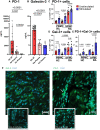Galectin-3 interacts with PD-1 and counteracts the PD-1 pathway-driven regulation of T cell and osteoclast activity in Rheumatoid Arthritis
- PMID: 36537046
- PMCID: PMC10078345
- DOI: 10.1111/sji.13245
Galectin-3 interacts with PD-1 and counteracts the PD-1 pathway-driven regulation of T cell and osteoclast activity in Rheumatoid Arthritis
Abstract
Rheumatoid arthritis (RA) is an autoimmune disease characterized by joint inflammation and bone erosions. The glycosylated programmed death-1 (PD-1) receptor plays an important role in regulating immune responses and maintaining tolerance. In this study, we focus on two features observed in RA: impaired PD-1 signalling and Galectin-3 (Gal-3) upregulation. We hypothesize that Gal-3 binds PD-1 and PD-1 ligands, potentially contributing to impaired PD-1 signalling. PD-1 and Gal-3 levels in RA synovial fluid (SF) and plasma were evaluated by ELISA. PD-1 and Gal-3 interaction was examined by Surface Plasmon Resonance and ELISA. PD-1, PD-L1 and Gal-3 expression on mononuclear cells from SF and peripheral blood as well as fibroblast-like synoviocytes were examined by flow cytometry. Effects of Gal-3 and PD-L1 on osteoclast formation was evaluated by tartrate-resistant acid phosphatase assay. We show that Gal-3 binds PD-1 and PD-L1. Results demonstrated high expression of PD-1 and Gal-3 on mononuclear cells, especially from SF. Gal-3 inhibited PD-1 signalling when PD-L1 was present. Furthermore, a role of Gal-3 in osteoclast formation was observed in vitro, both directly but also through PD-1:PD-L1 inhibition. Effects of Gal-3 on the PD-1 signalling axis are proposed to be inhibitory, meaning high Gal-3 levels in the complex synovial microenvironment are not desirable in RA. Preventing Gal-3's inhibitory role on PD-1 signalling could, therefore, be a therapeutic target in RA by affecting inflammatory T cell responses and osteoclasts.
Keywords: Galectin-3; PD-1; autoimmunity; co-inhibitory receptors; inflammation; rheumatoid arthritis.
© 2022 The Authors. Scandinavian Journal of Immunology published by John Wiley & Sons Ltd on behalf of The Scandinavian Foundation for Immunology.
Conflict of interest statement
Authors have no disclosures or competing interests.
Figures





Similar articles
-
Clinicopathological value of programmed cell death 1 (PD-1) and programmed cell death ligand 1 (PD-L1) expression in synovium of patients with rheumatoid arthritis.Clin Exp Med. 2018 Nov;18(4):487-494. doi: 10.1007/s10238-018-0515-4. Epub 2018 Jun 30. Clin Exp Med. 2018. PMID: 29961175
-
The programmed death 1/programmed death ligand 1 inhibitory pathway is up-regulated in rheumatoid synovium and regulates peripheral T cell responses in human and murine arthritis.Arthritis Rheum. 2010 Jul;62(7):1870-80. doi: 10.1002/art.27500. Arthritis Rheum. 2010. PMID: 20506224
-
The Programmed Death-1 Pathway Counter-Regulates Inflammation-Induced Osteoclast Activity in Clinical and Experimental Settings.Front Immunol. 2022 Mar 9;13:773946. doi: 10.3389/fimmu.2022.773946. eCollection 2022. Front Immunol. 2022. PMID: 35356000 Free PMC article.
-
Osteoclast Immunosuppressive Effects in Multiple Myeloma: Role of Programmed Cell Death Ligand 1.Front Immunol. 2018 Aug 10;9:1822. doi: 10.3389/fimmu.2018.01822. eCollection 2018. Front Immunol. 2018. PMID: 30147691 Free PMC article. Review.
-
Clinical Relevance of Galectin-1 and Galectin-3 in Rheumatoid Arthritis Patients: Differential Regulation and Correlation With Disease Activity.Front Immunol. 2019 Jan 9;9:3057. doi: 10.3389/fimmu.2018.03057. eCollection 2018. Front Immunol. 2019. PMID: 30687310 Free PMC article. Review.
Cited by
-
Gal-3 blocks the binding between PD-1 and pembrolizumab.J Immunother Cancer. 2024 Oct 2;12(10):e009952. doi: 10.1136/jitc-2024-009952. J Immunother Cancer. 2024. PMID: 39357979 Free PMC article.
-
Do galectins serve as soluble ligands for immune checkpoint receptors?J Immunother Cancer. 2024 Apr 9;12(4):e008984. doi: 10.1136/jitc-2024-008984. J Immunother Cancer. 2024. PMID: 38599662 Free PMC article. No abstract available.
-
Inhibition of LPS-Induced Inflammatory Response of Oral Mesenchymal Stem Cells in the Presence of Galectin-3.Biomedicines. 2023 May 24;11(6):1519. doi: 10.3390/biomedicines11061519. Biomedicines. 2023. PMID: 37371614 Free PMC article.
-
Molecular mechanisms and pathological implications of unconventional protein secretion in human disease: from cellular stress to therapeutic targeting.Mol Biol Rep. 2025 Feb 15;52(1):236. doi: 10.1007/s11033-025-10316-6. Mol Biol Rep. 2025. PMID: 39955475 Review.
-
PD-1 immunology in the kidneys: a growing relationship.Front Immunol. 2024 Oct 23;15:1458209. doi: 10.3389/fimmu.2024.1458209. eCollection 2024. Front Immunol. 2024. PMID: 39507530 Free PMC article. Review.
References
MeSH terms
Substances
Grants and funding
LinkOut - more resources
Full Text Sources
Medical
Research Materials

